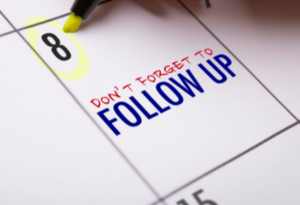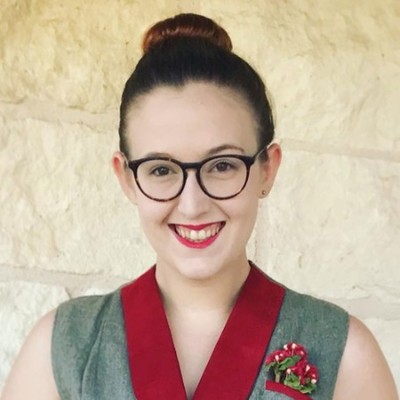INSIDE THE 
NEWS + ADVICE
How to Time Your Follow-Up and Stay Top of Mind

A successful job search involves more than sending in an application and waiting by the phone. Even if you meet with a recruiter at a job fair or have an interview with a hiring manager, there is still more to be done if you want to move the process forward. The next step is to follow up.
Many job seekers have a general idea of what follow-up looks like, but they don’t do it successfully. What should I say? How often can I reach out? How soon is too soon to call again? I’m not getting results—what am I doing wrong? If you’ve asked yourself these questions, you’re not alone.
Consider these tips to help you follow up with employers whether you’ve just met them at a job fair, applied for a job, or made it to the interview stage.
Following Up After a Job Fair
If you want to practice your follow-up skills, a job fair is the perfect place to jump into the deep end. You might speak with a dozen employers at one Cleared Job Fair. That’s a ton of people to add to your professional network if you follow through after the event.
Even if you don’t want to pursue a job opportunity at each of those companies, you should still follow up with a thank you note to each person you spoke with. One of those recruiters might have the perfect role for you down the line, or they might move to another company that you’re interested in.
If you network and follow up with recruiters, they can be your champions, whether they have the right fit for you or know the right person to connect you with. So be sure to ask for their business cards. If you’re participating in a virtual job fair, ask for their contact information and bookmark their LinkedIn URL so you can reach out to them after the event.
Once you have your recipients’ contact information, and hopefully some notes from your conversations too, follow up within 24 hours. Thank them for taking time to speak with you, and add one or two key points about why you would be an asset to their company. You can also share relevant information you forgot to mention, further detail about something you discussed, or refer back to something you chatted about to help them recall who you are.
It’s also helpful to attach your cleared resume, even if they already have a paper or digital copy. It saves them time tracking it down and makes it easy for them to forward it to a hiring manager. You’re helping to move the process forward and emphasize your interest.
I’ve Applied – Now What?
Following up throughout your job search is essential, but keep in mind the way you go about it must be meaningful. Simply calling up HR and asking if they got your resume won’t do the trick. Recruiters get dozens of emails and phone calls every day and they’re working to fill multiple positions, so they may not remember who you are amongst a sea of other applicants.
If you’re calling to check on the status of your application, begin by asking if they have a few minutes to chat. You should always be considerate and respectful of their time. Then give them some information to work with, such as the position you applied for and also how you got their name.
Perhaps you were told a week ago that your application was under consideration. Share this information and tell them you’re following up to learn the current status and to see if you can provide any additional information or answer any questions. By framing the conversation like this, you make it meaningful.
Perhaps you’re more comfortable with an email at this point in the process. If you opt for email instead, make sure you do some research and identify someone in particular to send your message to. Forget, “To Whom it May Concern.” You increase your odds of your email being read if you include someone’s name.
Your outcome will be even greater if you did some research before applying to find a point of contact at the company. Maybe you met someone from the company at a recent job fair. Job search is all about networking, so check LinkedIn and other social media platforms to see if you have existing connections.
Thank You Goes a Long Way After an Interview
Once you’ve made it to the interview stage of the hiring process, it’s time to really get serious about your follow-up routine. Begin by sending a thank you note within 24-48 hours of your interview.
For a phone or video interview, send your note via email and keep it fairly short. You might restate how you can add value to the employer, touch on a relevant skill or experience you didn’t discuss during your interview, and express your continued interest in the position.
If you had an in-person interview, be sure to collect business cards from every person you meet so you can send them each thank you notes, just like at a job fair. And have a bit of variety in your emails—don’t send the same message verbatim to each recipient. A thank you note can lead to a job offer, so take time to write them thoughtfully, build the relationship further, and make a great impression.
The Key to Timing Your Follow-Up
During each of your interactions with recruiters and hiring managers, ask when you can expect to hear back from them. This is vital so that you can time your follow-up accordingly. If they said to expect a call in a week, you know to call them by week two if you haven’t heard back. This resolves any question you might have about when is the right time to reach back out.
Reaching out via email or phone is up to you – whichever you are more comfortable with will do the job. If you’ve had an interview with the hiring manager, contact them first, then the recruiter.
When it comes to how much follow-up is too much, consider these guidelines. If you’ve had a phone interview, aim for one thank you note and one follow-up call or email. After an in-person interview, especially one with multiple people, you can add an extra one or two follow-up emails or calls. But don’t inundate your contact with phone calls and emails every day.
They have other positions to fill and get tons of phone calls, so space your follow-up attempts by about a week to 10 days apart, and keep track of each time you’ve followed up. You might follow up two to four times over three to four weeks.
When you do follow up, be sure to:
- State who you are and what the job is.
- Say you’re checking to see how their decision-making process is going.
- Ask if they need any more information.
- Leave your full name and phone number.
- Convey that you’re still interested in the position.
You might feel upset that you haven’t heard back from an employer at times, but don’t get angry or express your frustrations in your communications. Stay positive, professional, and concise.
Meaningful follow-up is not a one-time action. It takes time and effort to stay in touch and remain visible. At the end of the day, people hire people. This is why building the relationship with meaningful follow-up communication is so important to job search success.
This entry was posted on Tuesday, March 01, 2022 11:39 am
